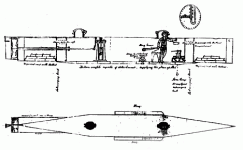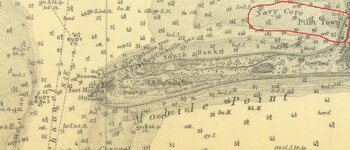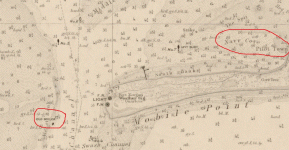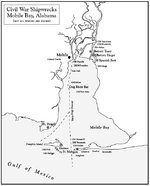Almost everyone is familiar with the story of the Confederate submarine Hunley. She became the first submarine to sink an enemy ship in combat on Feburary 17, 1864.
What is less well known is the mystery surrounding the loss of her immediate predecessor, a prototype submarine at first called Pioneer II and later renamed American Diver.
Both submarines were built by a group of investors led by Horace Lawson Hunley and engineer James McClintock. American Diver was built in late 1862 in Mobile, AL.
Raw materials were scarce in the South during the Civil War, so American Diver was built from an old boiler.
McClintock at first experimented with electric motors and even steam engines in an effort to find a suitable power plant for his submarine, but was forced to fall back on human power.
American Diver, like Hunley, was powered by a hand crank. This made her slow and greatly reduced her efficiency because turning the crank exhausted the crew in a short period of time. Here is one of McClintock's drawings (sorry about the poor quality):

The submarine project was carried out with the support of the Confederate States government, but was, obviously, top secret.
Very little information can be gleaned from the official records. Almost everything known about American Diver comes from a few private letters.
Correspondance from Mobile harbor pilots indicate that American Diver was kept at Navy Cove, just inside the harbor entrance. This very much stands to reason, since one of the great challenges to the successful use of the sub would have been getting her into position among the Federal Blockading Squadron patrolling outside of the range of the guns of Fort Morgan.
At some time in Feburary, 1863, American Diver was being towed from Navy Cove in an attempt to get her into position to assault the blockading ships. Her crew was aboard the towing vessel to conserve energy for the attack. However, a sudden squall upset the sub, and an unsecured hatch caused her to sink---acccording to McClintock, somewhere near the entrance to Mobile Bay. She has never been found.
I have attached some old charts showing Navy Cove in relation to Mobile Bay entrance. The submarine is probably buried under tons of sediment ---but not necessarily.
 Mobile Bay, 1856
Mobile Bay, 1856
On a "long shot" possibiity, I am also attaching a portion of a chart from 1877 showing an "old boiler" near the main ship channel. This "old boiler" was uncharted in 1856. It makes it first appearance on a chart in 1877.
 Mobile Bay, 1877
Mobile Bay, 1877
Remember, the American Diver project was top secret. It is almost inconceivable that the men conducting the survey of Mobile Bay in 1877 would have known about the submarine"s existence.
While there are many wrecks located in and around Mobile Bay, it is just possible that a survey team might mistake a submarine fashioned from an old boiler for---an "old boiler".
In any event, this "old boiler" apparently showed up, in situ, sometime between 1856 and 1877...
Talk about Steam Punk !!!
What is less well known is the mystery surrounding the loss of her immediate predecessor, a prototype submarine at first called Pioneer II and later renamed American Diver.
Both submarines were built by a group of investors led by Horace Lawson Hunley and engineer James McClintock. American Diver was built in late 1862 in Mobile, AL.
Raw materials were scarce in the South during the Civil War, so American Diver was built from an old boiler.
McClintock at first experimented with electric motors and even steam engines in an effort to find a suitable power plant for his submarine, but was forced to fall back on human power.
American Diver, like Hunley, was powered by a hand crank. This made her slow and greatly reduced her efficiency because turning the crank exhausted the crew in a short period of time. Here is one of McClintock's drawings (sorry about the poor quality):

The submarine project was carried out with the support of the Confederate States government, but was, obviously, top secret.
Very little information can be gleaned from the official records. Almost everything known about American Diver comes from a few private letters.
Correspondance from Mobile harbor pilots indicate that American Diver was kept at Navy Cove, just inside the harbor entrance. This very much stands to reason, since one of the great challenges to the successful use of the sub would have been getting her into position among the Federal Blockading Squadron patrolling outside of the range of the guns of Fort Morgan.
At some time in Feburary, 1863, American Diver was being towed from Navy Cove in an attempt to get her into position to assault the blockading ships. Her crew was aboard the towing vessel to conserve energy for the attack. However, a sudden squall upset the sub, and an unsecured hatch caused her to sink---acccording to McClintock, somewhere near the entrance to Mobile Bay. She has never been found.
I have attached some old charts showing Navy Cove in relation to Mobile Bay entrance. The submarine is probably buried under tons of sediment ---but not necessarily.
 Mobile Bay, 1856
Mobile Bay, 1856On a "long shot" possibiity, I am also attaching a portion of a chart from 1877 showing an "old boiler" near the main ship channel. This "old boiler" was uncharted in 1856. It makes it first appearance on a chart in 1877.
 Mobile Bay, 1877
Mobile Bay, 1877Remember, the American Diver project was top secret. It is almost inconceivable that the men conducting the survey of Mobile Bay in 1877 would have known about the submarine"s existence.
While there are many wrecks located in and around Mobile Bay, it is just possible that a survey team might mistake a submarine fashioned from an old boiler for---an "old boiler".
In any event, this "old boiler" apparently showed up, in situ, sometime between 1856 and 1877...
Talk about Steam Punk !!!
Last edited:



